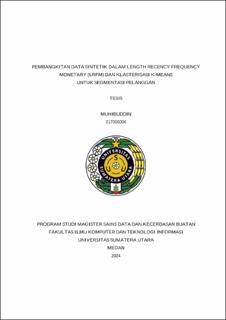Pembangkitan Data Sintetik dalam Length Recency Frequency Monetary (LRFM) dan Klasterisasi K-Means untuk Segmentasi Pelanggan
Synthetic Data Generation for Length, Recency, Frequency, Monetary (LRFM) Analysis and K-Means Clustering in Customer Segmentation

Date
2024Author
Muhibuddin, Muhibuddin
Advisor(s)
Nababan, Erna Budhiarti
Fahmi
Metadata
Show full item recordAbstract
Customer segmentation is a critical component in developing effective marketing strategies, yet obtaining accurate and comprehensive customer datasets frequently poses significant challenges. This study investigates the feasibility of synthetic data generated through Time-series Generative Adversarial Networks (TimeGAN) to augment Length, Recency, Frequency, and Monetary (LRFM) analysis and K-Means clustering for customer segmentation. TimeGAN was selected for its capacity to capture temporal dependencies in sequential data, while the LRFM framework was employed to elucidate key behavioral dimensions of customers. K-Means served as the clustering algorithm, with Silhouette Coefficient and Davies-Bouldin Index as performance indicators.
Experimental results reveal that the synthetic dataset achieved a Silhouette Coefficient of 0.42, marginally higher than the real dataset’s 0.41. Meanwhile, the Davies-Bouldin Index for the synthetic data was 0.90, closely paralleling the real data’s 0.89. These findings indicate that synthetic data effectively replicates the intrinsic patterns and distributions of actual datasets without compromising the integrity or quality of the clustering outcomes. By integrating synthetic data with LRFM analysis and K-Means clustering, this research provides valuable insights into customer segmentation, underscoring the potential of synthetic data as a reliable alternative when real-world data are scarce or unavailable. Consequently, the study highlights the broader practical implications of leveraging synthetic data, particularly in preserving data confidentiality and mitigating privacy concerns.
Collections
- Master Theses [20]
